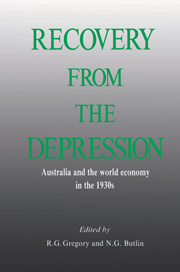Book contents
- Frontmatter
- Contents
- LIST OF AUTHORS
- LIST OF FIGURES
- LIST OF TABLES
- PREFACE
- 1 AN OVERVIEW
- 2 THE AUSTRALIAN RECOVERY OF THE 1930s IN INTERNATIONAL COMPARATIVE PERSPECTIVE
- 3 THE RECOVERY OF THE 1930s AND ECONOMIC POLICY IN BRITAIN
- 4 A MACRO INTERPRETATION OF RECOVERY: AUSTRALIA AND CANADA
- 5 DEPRESSION AND RECOVERY IN NEW ZEALAND
- 6 THE JAPANESE ECONOMY AND ECONOMIC POLICY IN THE 1930s
- 7 THE BATTLE OF THE PLANS: A MACROECONOMETRIC MODEL OF THE INTERWAR ECONOMY
- 8 AUSTRALIAN BUDGETARY POLICIES IN THE 1930s
- 9 MONETARY POLICY IN DEPRESSION AND RECOVERY
- 10 SHARING THE BURDEN: THE AUSTRALIAN LABOUR MARKET DURING THE 1930s
- 11 MANUFACTURING AND ECONOMIC RECOVERY IN AUSTRALIA, 1932–1937
- 12 AGRICULTURE AND THE RECOVERY FROM THE DEPRESSION
- 13 UNEMPLOYMENT AND THE AUSTRALIAN ECONOMIC RECOVERY OF THE 1930s
- 14 GOVERNMENT UNEMPLOYMENT RELIEF IN THE 1930s: AID OR HINDRANCE TO RECOVERY?
- 15 UNEQUAL SACRIFICE: DISTRIBUTIONAL ASPECTS OF DEPRESSION AND RECOVERY IN AUSTRALIA
- REFERENCES
- INDEX
4 - A MACRO INTERPRETATION OF RECOVERY: AUSTRALIA AND CANADA
Published online by Cambridge University Press: 24 November 2009
- Frontmatter
- Contents
- LIST OF AUTHORS
- LIST OF FIGURES
- LIST OF TABLES
- PREFACE
- 1 AN OVERVIEW
- 2 THE AUSTRALIAN RECOVERY OF THE 1930s IN INTERNATIONAL COMPARATIVE PERSPECTIVE
- 3 THE RECOVERY OF THE 1930s AND ECONOMIC POLICY IN BRITAIN
- 4 A MACRO INTERPRETATION OF RECOVERY: AUSTRALIA AND CANADA
- 5 DEPRESSION AND RECOVERY IN NEW ZEALAND
- 6 THE JAPANESE ECONOMY AND ECONOMIC POLICY IN THE 1930s
- 7 THE BATTLE OF THE PLANS: A MACROECONOMETRIC MODEL OF THE INTERWAR ECONOMY
- 8 AUSTRALIAN BUDGETARY POLICIES IN THE 1930s
- 9 MONETARY POLICY IN DEPRESSION AND RECOVERY
- 10 SHARING THE BURDEN: THE AUSTRALIAN LABOUR MARKET DURING THE 1930s
- 11 MANUFACTURING AND ECONOMIC RECOVERY IN AUSTRALIA, 1932–1937
- 12 AGRICULTURE AND THE RECOVERY FROM THE DEPRESSION
- 13 UNEMPLOYMENT AND THE AUSTRALIAN ECONOMIC RECOVERY OF THE 1930s
- 14 GOVERNMENT UNEMPLOYMENT RELIEF IN THE 1930s: AID OR HINDRANCE TO RECOVERY?
- 15 UNEQUAL SACRIFICE: DISTRIBUTIONAL ASPECTS OF DEPRESSION AND RECOVERY IN AUSTRALIA
- REFERENCES
- INDEX
Summary
Introduction
The prevailing myth, in Canada at least, is that the Great Depression of the 1930s came to an end only with the outbreak of World War EL This is not an unreasonable interpretation of events given the prolonged time that the depression went on and the dramatic changes that occurred after 1939. The source of this interpretation is the persistence of unemployment during the decade. The goal of this chapter is to provide a more balanced view. The basic methodology is comparative economic history. We analyse the economic data for Australia and Canada using a simple macroeconomic model of an open economy.
The first conclusion one can draw from the course of real output change in Australia and Canada as revealed in Figures 4.1 and 4.2 is that recovery did not wait until the outbreak of hostilities in 1939. By 1932 in Australia and by 1934 in Canada, real growth was again positive and remained that way for the balance of the decade. The second point is that level of growth differed quite substantially during the recovery period. In Australia the average annual rate of real output expansion was between 3 and 4 per cent while in Canada it moved around a level slightly above 8 per cent. Of course the fall in output between 1930 and 1933 was much sharper in Canada. Thirdly, in both countries growth rates reached a ceiling by the mid-1930s and then cycled around this ceiling.
- Type
- Chapter
- Information
- Recovery from the DepressionAustralia and the World Economy in the 1930s, pp. 89 - 112Publisher: Cambridge University PressPrint publication year: 1989
- 2
- Cited by



